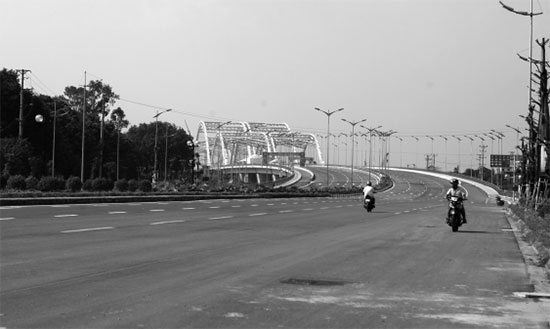Inspectorate uncovers violations at major road project

Crowning the commemorative celebration of the 1,000-year Thang Long-Hanoi, such violations turned one of the biggest infrastructure projects into an archetype of poor investment efficiency in public investment management.
Accordingly, on March 31, the Government Office issued Document 2153/VPCP-V.I on post-inspection treatment measures to National Highway 5’s 13.3- kilometre extension project.
According to Deputy Prime Minister Nguyen Xuan Phuc (now Prime Minister)’s guidelines, the Hanoi People’s Committee must review and clarify the responsibilities of authorised bodies and individuals related to the wrongdoings and violations highlighted in the inspectors’ conclusion report.
The Committee was also required to radically tackle the inspectorate’s proposals related to the project’s economic aspects and report to the prime minister before the end of June, 2016.
Earlier, in late December 2015, the Government Inspectorate issued its conclusions after nearly two years of inspection at the project, indicating the complicity and scope of violations.
The National Highway 5 extension project is of special significance to Hanoi’s transport network, as it links the areas north of Hanoi city to the northern economic triangle consisting of Hanoi, Haiphong, and Quang Ninh, through belt road systems II and III.
The project, therefore, was approved by the Prime Minister to be among the projects celebrating the 1,000-year Thang Long-Hanoi anniversary.
The project is developed by Ta Ngan Infrastructure Project Management Unit, under the direct management of Hanoi People’s Committee.
The Ministry of Transport’s Transport Engineering Design Inc. (TEDI) was appointed to take charge of drawing, appraising, and approving the investment plan as well as the blue print.
The project’s investment capital was gathered from the auction of land use rights, and a temporary allocation of the state budget, if this sum is deemed insufficient.
The inspection highlighted a lot of violations and wrongdoings at the project. At the time of inspection, the bidding packages were not completed yet, a delay of more than six years, according to schedule.
Following the project’s bidding plan, which was approved by the Hanoi People’s Committee, the project consisted of 13 bidding packages, going underway from June 2005 and slated for completion in 2008.
The implementation, in fact, was patchy. Two packages were started in 2005, four in 2006, and two more in 2008. Five remaining packages were commenced five years later.
Defaulting on deadlines has driven up the project’s total investment capital from VND3.53 trillion ($162 million) to VND6.6 trillion ($305 million), which explains the inspector’s assumption that the project wasted state budget and reported low investment efficiency.
Besides, financial violations amounting to VND657 trillion ($30 million), approximately 10 per cent of the total investment cost, were detected by government inspectors.
What the stars mean:
★ Poor ★ ★ Promising ★★★ Good ★★★★ Very good ★★★★★ Exceptional
Latest News
More News
- Kim Long deal marks turning point for Vietnam’s auto industry (December 10, 2025 | 18:44)
- Pernod Ricard Vietnam supports flood-hit localities (December 10, 2025 | 14:18)
- SABECO honoured at Vietnam M&A Forum for outstanding deal of 2024-2025 (December 10, 2025 | 12:00)
- Vietnam raises taxable revenue threshold for household businesses to VND500 million (December 10, 2025 | 11:34)
- Vietnam M&A Forum 2025: new position, new momentum (December 09, 2025 | 14:30)
- Masan Consumer reveals HSX listing roadmap (December 09, 2025 | 14:09)
- Industrial sector posts robust gains as year-end demand rises (December 09, 2025 | 13:38)
- Foreign fruits flood Vietnamese market (December 09, 2025 | 13:22)
- Phu Tai Group and FPT accelerate digital governance with SAP cloud ERP (December 09, 2025 | 12:41)
- MSD brings HPV Holobox tour to Vietnam (December 09, 2025 | 10:42)

















 Mobile Version
Mobile Version